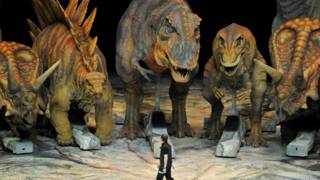 Image copyright AFP
Image copyright AFP Recently, the fossilized fragments of the skeleton of a new member of the genus tyrannosaurs were found in Uzbekistan and this discovery could be the key to solving the mystery of the huge size of these unique creatures.
Scientists Edinburgh University together with colleagues from Russia and the US have discovered the fossilized remains of the animal in the center of the Kyzylkum desert in Uzbekistan.
a new genus of dinosaur named Tamerlane (Timurlengia euotica) in honor of medieval military leader Tamerlane.
By studying the remains of a dinosaur, the estimated age of 90 million years, scientists have suggested that his ears and brain were crucial in a dominant position, which at one time occupied tyrannosaurs in the animal world
“We have discovered a completely new type of dinosaur -. explained lead researcher of the University of Edinburgh Stephen Bryusatt. – This is one of the closest relatives of Tyrannosaurus rex, but much smaller in size -. About a horse “
Tyrannosaurus as well as Tamerlane, lived in the Cretaceous period, though later in his department – the lower body length of Tyrannosaurus from. head to tail reached 13 meters
“This kind (Tamerlane) lived in the middle of the Cretaceous period – just at the point where we have a huge gap in the fossil record.” – he added
Because of this, Tyrannosaurus was a real evolutionary mystery it is in this period -. about 90 million years ago – Tyrannosaurus began to evolve and become one of the largest predators that ever lived on this planet
Despite the fact that Tamerlane is much inferior to the Tyrannosaurus size, it had a large and developed brain.
It may have helped him evolve into a fairly smart and physical development of a Tyrannosaurus rex.
“Tamerlane has some features of the bones, which are also found in Tyrannosaurus rex – Dr. Bryusatt said -. So that these evolutionary features which ultimately allowed the Tyrannosaurus rex become superdominantnym view, is the last link of the food chain “
the team studied 25 different parts of the skeleton Tamerlane, collecting them as. mosaic, to understand what was the size and shape of the dinosaur.
the most promising for the study was a small part of the animal’s skull. The team scanned it to reconstruct the shape and size of his brain, and especially the inner ear structure, as well as trying to create a picture of his sensory capabilities.
“Thanks to computer tomography, we could see that his brain and ear were almost identical Tyrannosaurus “, – said Dr. Bryusatt
.” So in his skull was a “central processing unit”, where all the intelligence was focused, all developed senses inherent tyrannosaurs, and perhaps that is exactly that tyrannosaurs allowed to become so large “- suggests Bryusatt
.
No comments:
Post a Comment